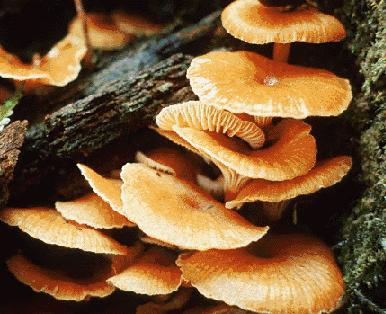Powerpoint All Fungi Phyla
1. Oomycota The Protist-like Fungi

Oomycota are represented by organisms such as water molds and potato blight. They are closely related to the plant-like protists myxomycota. Both are multi-nucleate (they do not have cross walls, so the nuclei are floating freely in the mycelia).
- Unlike most other Fungi, Oomycota cell walls are made out of cellulose, not chitin
- They are capable of Asexual and sexual reproduction
- They are the only ones to produce motile spores
2. Zygomycota The common molds

Zygomycota are represented by organisms such as black bread mold.
Their are three types of mycelia which serve different functions in:
- Sporangiophores mycelia that stick straight up into the air. Their job is to hold the sporangia (the black ball of spores) up into the air
- Stolon mycelia that travel along sideways, their job is to meet with another organism, where they can then exchange genetic information
- Rhizoids mycelia that penetrate the surface of whatever the mold is growing on top of. Their function is to secrete enzymes to break down the food and absorb it.
- Like Oomycota, they have no cross walls in their mycelia, therefore, they are multi-nucleate
- Both asexual and sexual reproduction occur
- Haploid in most life stages
- Diploid zygospore (a zygospore is a structure that is created when two stolons meet, where genetic information is combined)
3. Ascomycota The sac fungi

Ascomycota are represented by organisms such as morel, cup fungi, yeast and cordyceps. They are named for the tiny sac like structures in their reproductive parts, called “ascus”.
- Ascus – tiny sacs where haploid spores are produced for sexual reproduction
- Ascospores – the tiny spores produced by sexual reproduction
Ascomycota are also capable of asexual repdocution. They have different structures for this:
- Conidium – structure where spores are produced via mitosis. These spores have not been combined with another organism, which means they are genetically identical to the parent.
- Condiospores – spores produced by asexual reproduction
4. Basidomycota The club fungi

Almost any of the organisms we think of as “mushrooms” belong to this phylum. For example: ling zhi, honey mushroom, fly agaric, white puffball, coral fungus and portobello mushrooms all belong to this phylum.
Most members in this phyla produces very elaborate reproductive structures. On the underside of mushrooms, are gills which contain many millions of basidia. These basidia produce basidiospores.
Basidia start out as dikaryotic cells (where two haploid nuclei exist in one cell; N+N). These two nuclei exist separately, originating from different organisms. Eventually the two nuclei will fuse to form a true diploid cell (2N). These diploid cells will then undergo meiosis to create haploid cells (N). These haploid cells are the spores, called basidiospores.
5. Deuteromycota The imperfect fungi

Deuteromycota is the miscellaneous pile of the kingdom. Any fungi that do not fit in the other four are placed in this phylum. However, they do share one trait in common: members of Deuteromycota do not have a sexual life cycle.
Examples of Deuteromycota include such things as Penicillium and Athlete’s foot.

%20square.jpg)









